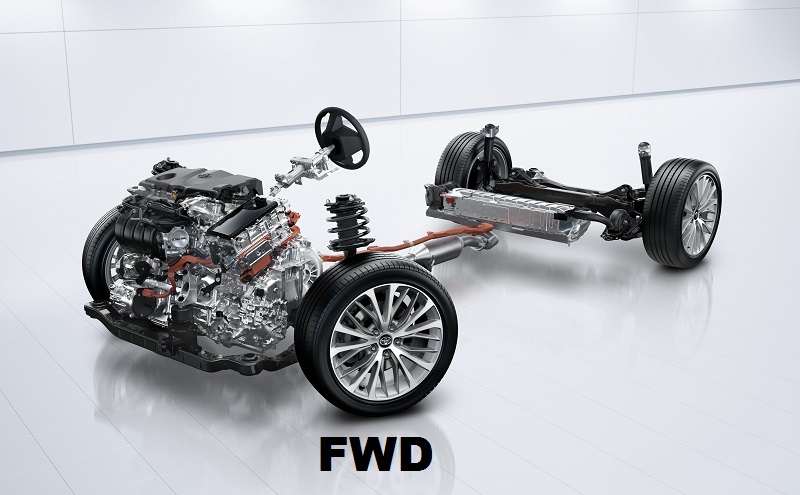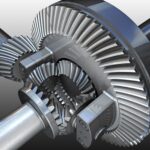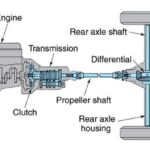
Advantages of Front Wheel Drive-
1. Interior space: Since the powertrain is a single unit contained in the engine compartment of the vehicle, there is no need to devote interior space for a driveshaft tunnel or rear differential, increasing the volume available for passengers and cargo.
2. Cost: Fewer components overall
3. Weight: Fewer components mean lower weight
4. Fuel economy: Lower weight means better gasoline mileage
5. Improved drivetrain efficiency: the direct connection between engine and transaxle reduce the mass and mechanical inertia of the drivetrain compared to a rear-wheel drive vehicle with a similar engine and transmission, allowing greater fuel economy.
6. Assembly efficiency: the powertrain can be often be assembled and installed as a unit, which allows more efficient production.
7. Slippery-surface traction: placing the mass of the drivetrain over the driven wheels improves traction on wet, snowy, or icy surfaces. Although heavy cargo can be beneficial for traction on rear-wheel drive pickup trucks.
8. Predictable handling characteristics: front-wheel drive cars, with a front weight bias, tend to understeer at the limit, which is commonly believed to be easier for average drivers to correct than terminal oversteer, and less prone to result in fishtailing or a spin.
9. Better crosswind stability.
10. Tactile feedback via the steering wheel informing driver if a wheel is slipping.
11. Front wheel drive allows the use of left-foot braking as a driving technique.
Disadvantages of Front Wheel Drive-
1. The centre of gravity of the vehicle is typically farther forward than a comparable rear-wheel drive layout. In front wheel drive cars, the front axle typically supports around 2/3rd of the weight of the car (quite far off the “ideal” 50/50 weight distribution). This is a contributing factor in the tendency of front wheel drive cars to understeer.
2. Torque steer can be a problem on front wheel drive cars with higher torque engines ( > 210 N·m ) and transverse layout. This is the name given to the tendency for some front wheel drive cars to pull to the left or right under hard acceleration. It is a result of the offset between the point about which the wheel steers (which falls at a point which is aligned with the points at which the wheel is connected to the steering mechanisms) and the centroid of its contact patch. The tractive force acts through the centroid of the contact patch, and the offset of the steering point means that a turning moment about the axis of steering is generated. In an ideal situation, the left and right wheels would generate equal and opposite moments, cancelling each other out, however in reality this is less likely to happen. Torque steer is often incorrectly attributed to differing rates of twist along the lengths of unequal front drive shafts. However, Centre-point steering geometry can be incorporated in the design to avoid torque steer. This is how the powerful Citroen SM front-wheel drive car avoided the problem.
3. Lack of weight shifting will limit the acceleration of a front wheel drive vehicle. In a rear wheel drive car the weight shifts back during acceleration giving more traction to the driving wheels. This is the main reason why nearly all racing cars are rear wheel drive. However, since front wheel cars have the weight of the engine over the driving wheels the problem only applies in extreme conditions.
4. In some towing situations front wheel drive cars can be at a traction disadvantage since there will be less weight on the driving wheels. Because of this, the weight that the vehicle is rated to safely tow is likely to be less than that of a rear wheel drive or four wheel drive vehicle of the same size and power.
5. Due to geometry and packaging constraints, the CV joints (constant-velocity joints) attached to the wheel hub have a tendency to wear out much earlier than their rear wheel drive counterparts The significantly shorter drive axles on a front wheel drive car causes the joint to flex through a much wider degree of motion, compounded by additional stress and angles of steering, while the CV joints of a rear wheel drive car regularly see angles and wear of less than half that of front wheel drive vehicles.
6. The driveshaft’s may limit the amount by which the front wheels can turn, thus it may increase the turning circle of a front wheel drive car compared to a rear wheel drive one with the same wheelbase.
7. In low traction conditions (i.e.: ice or gravel) the front (Drive) Wheels lose traction first making steering ineffective.


